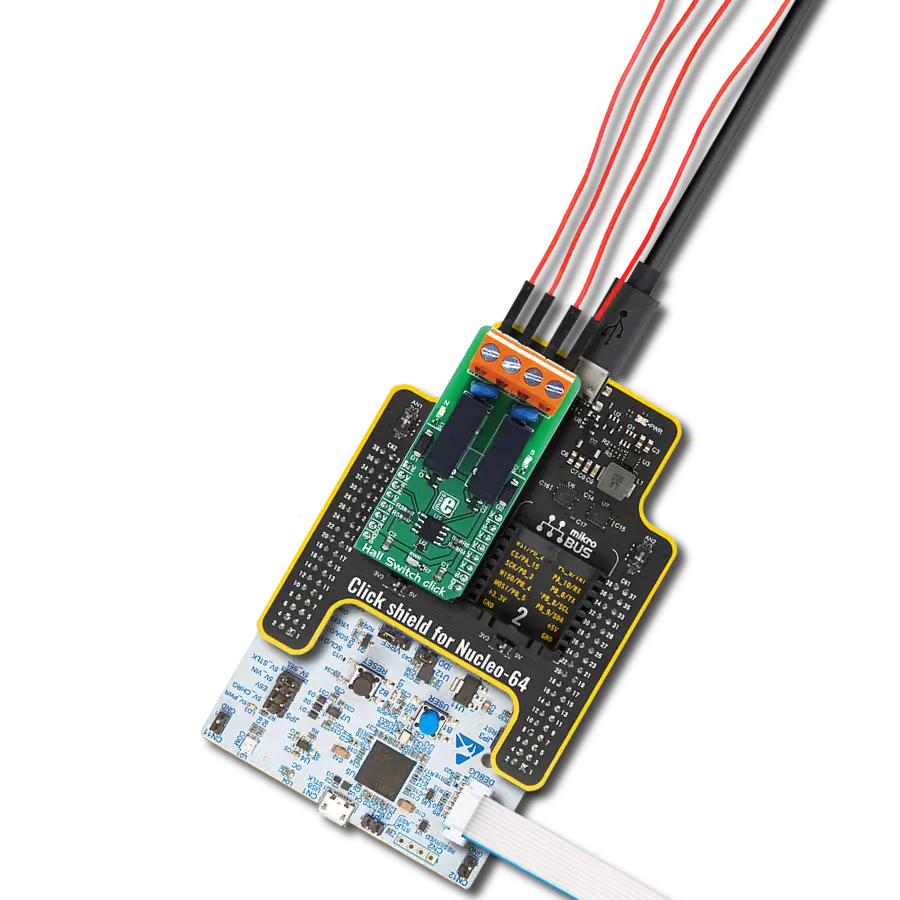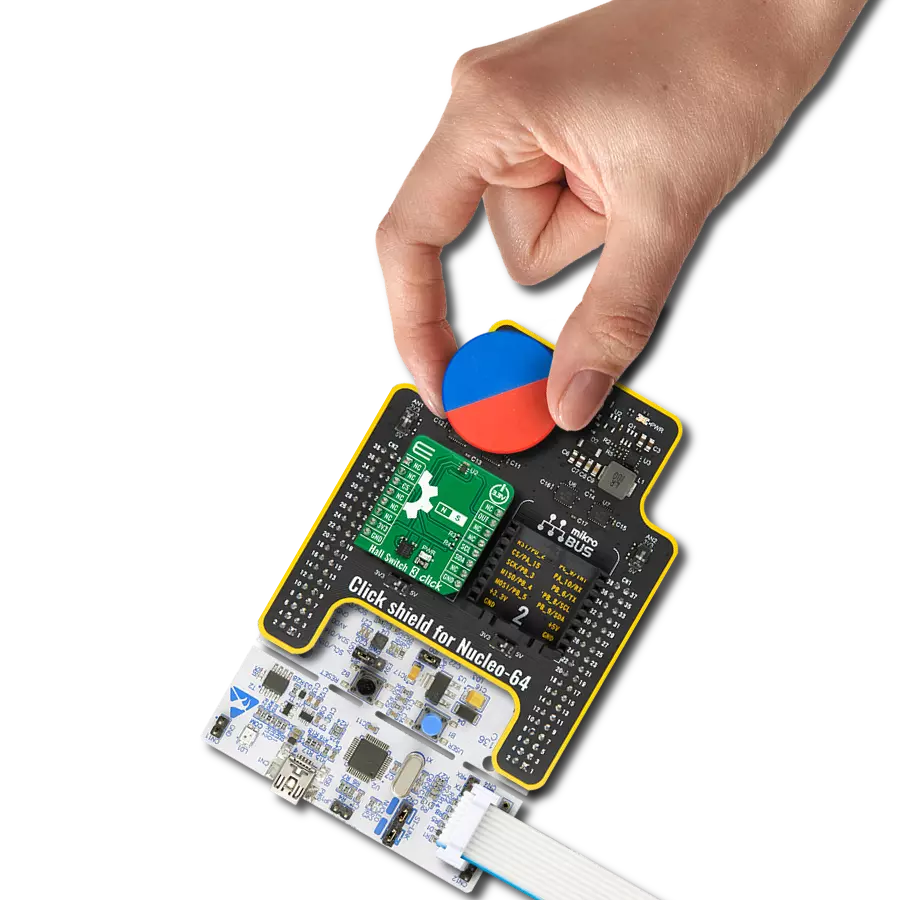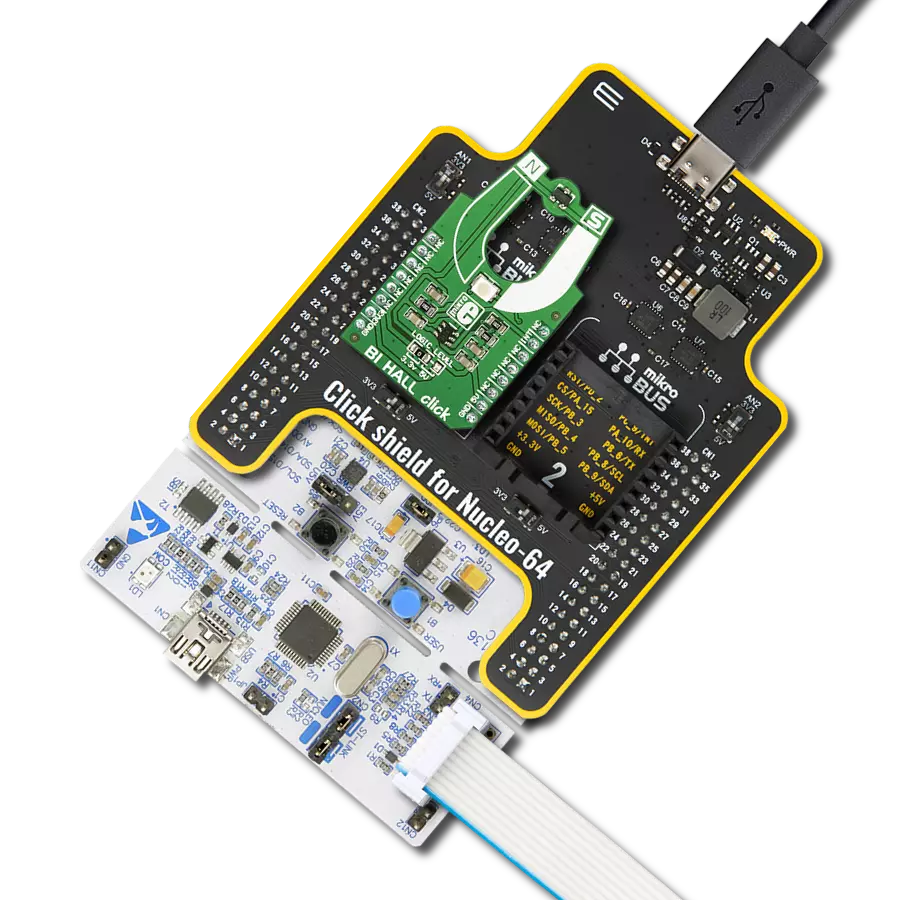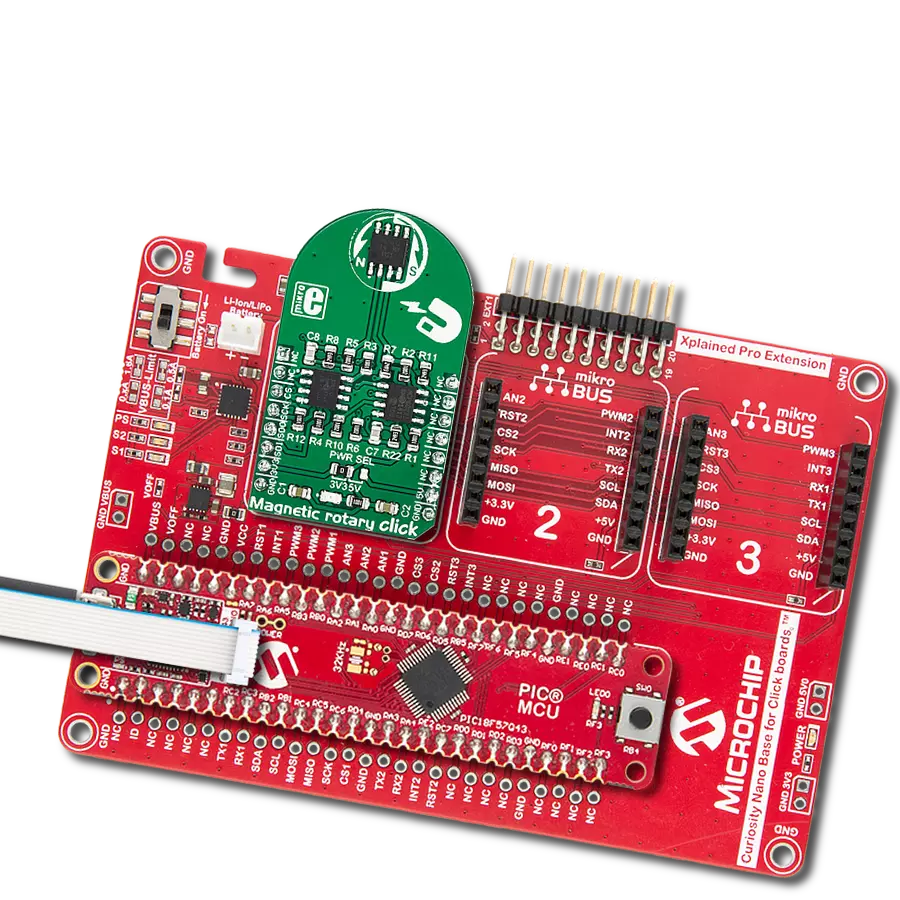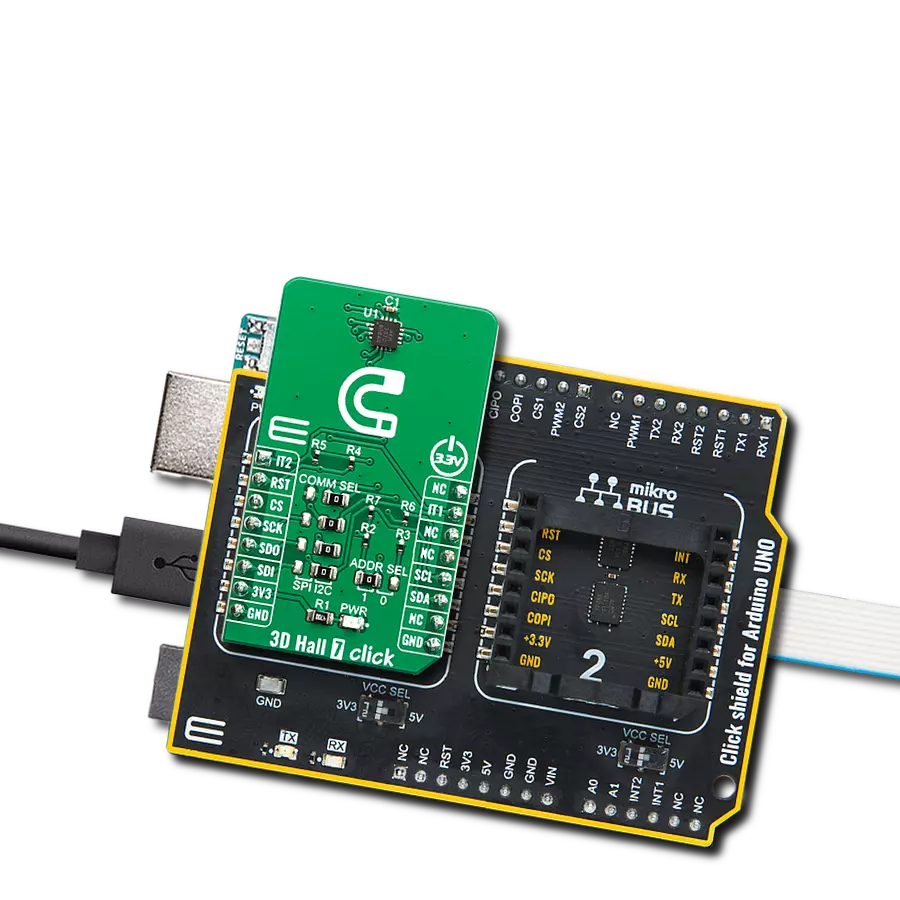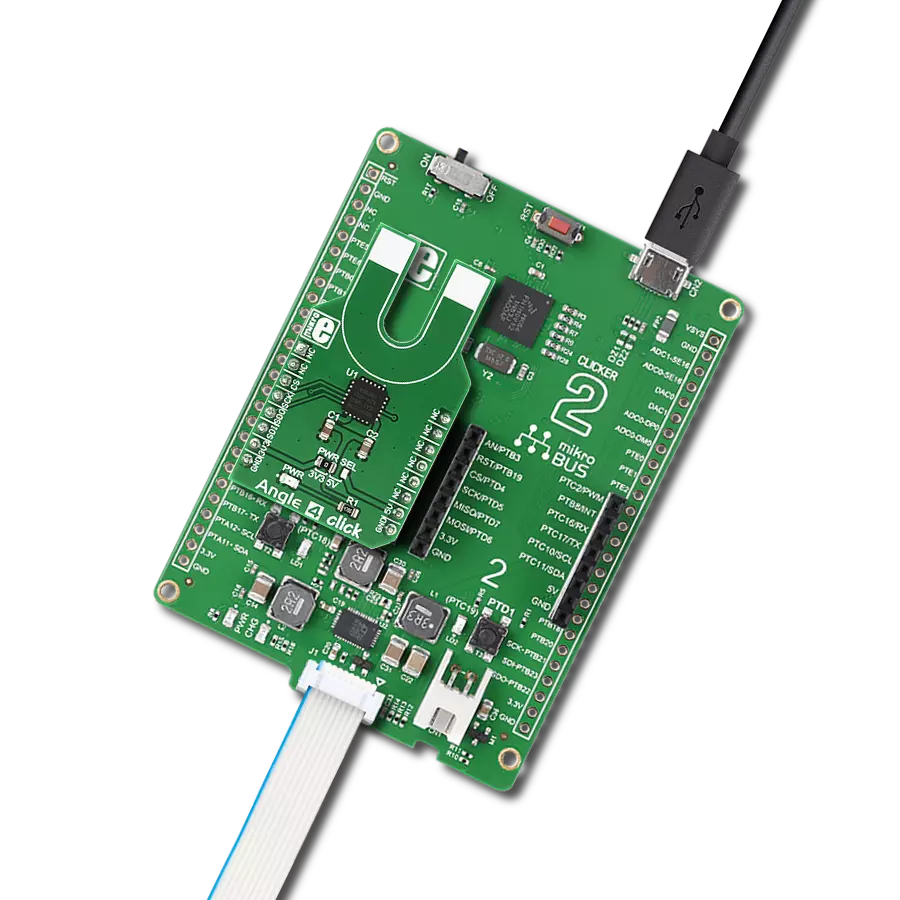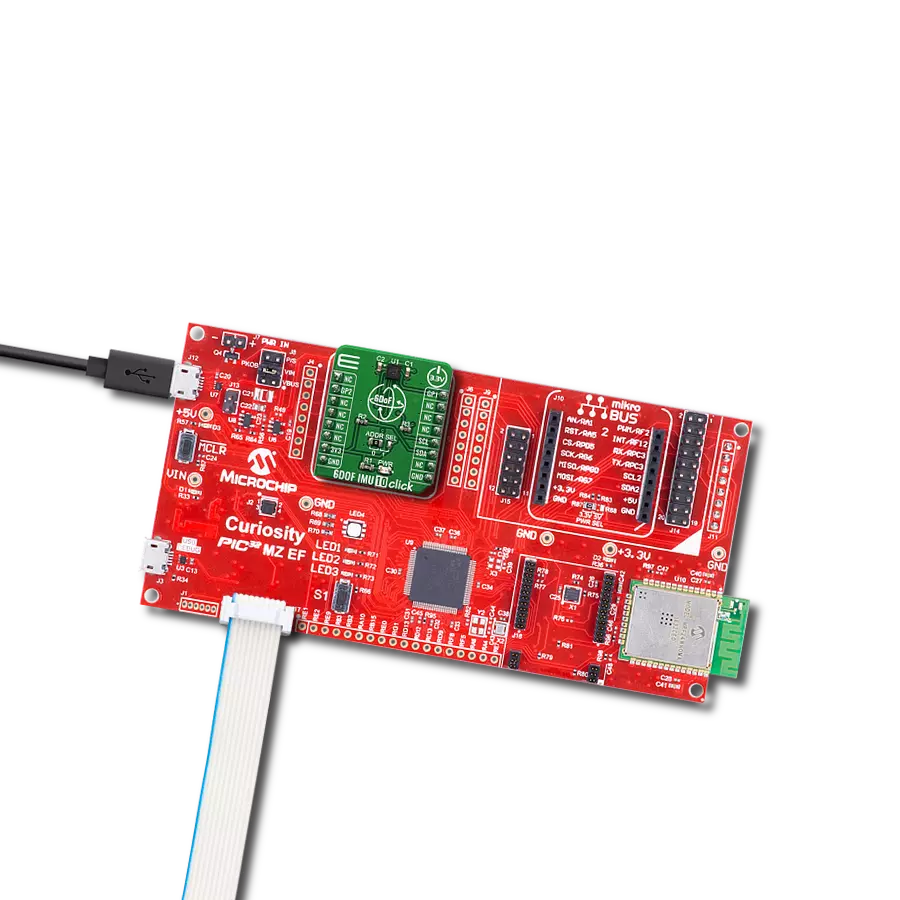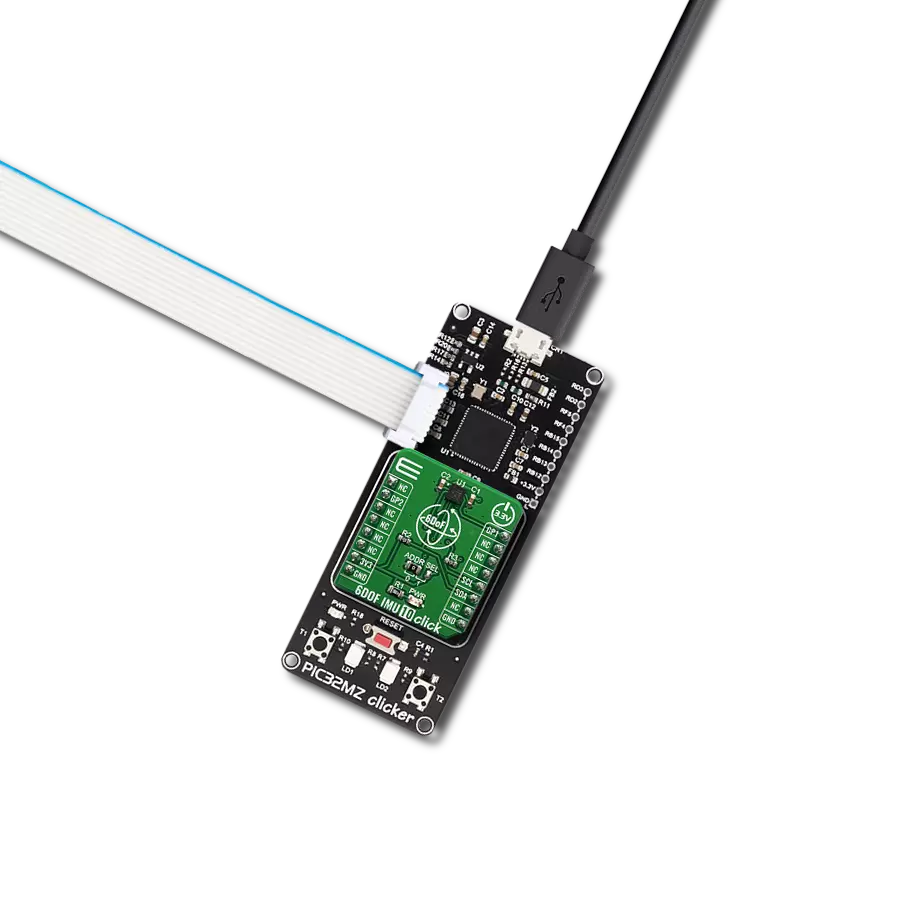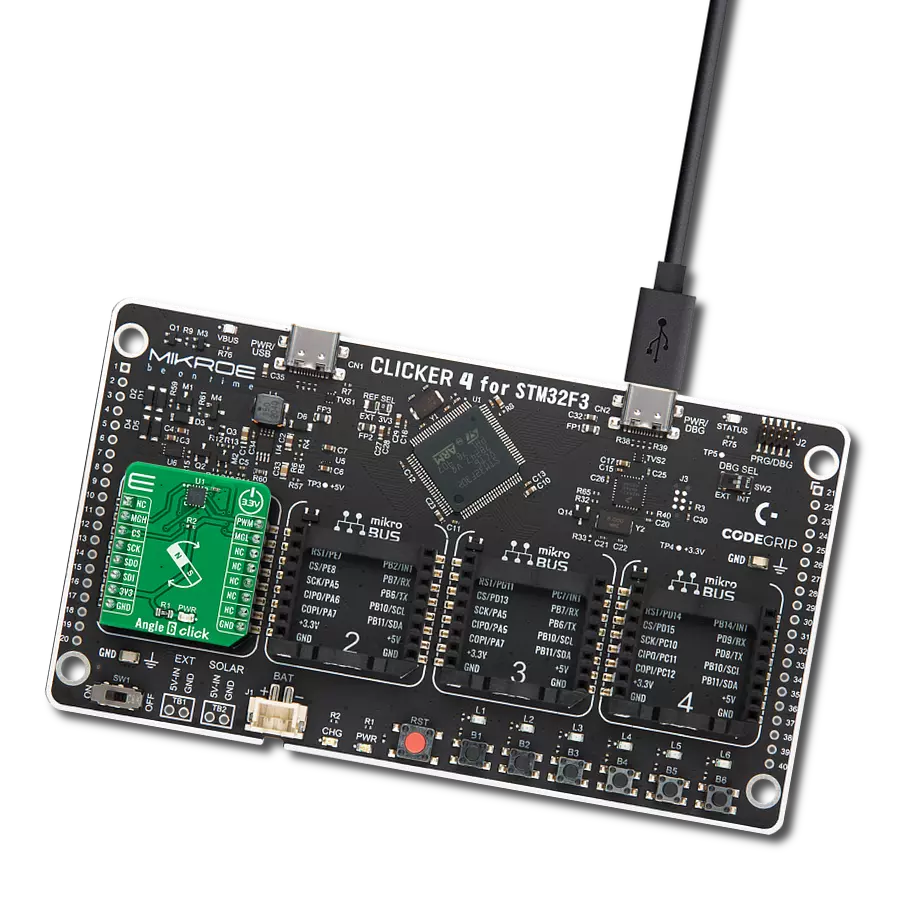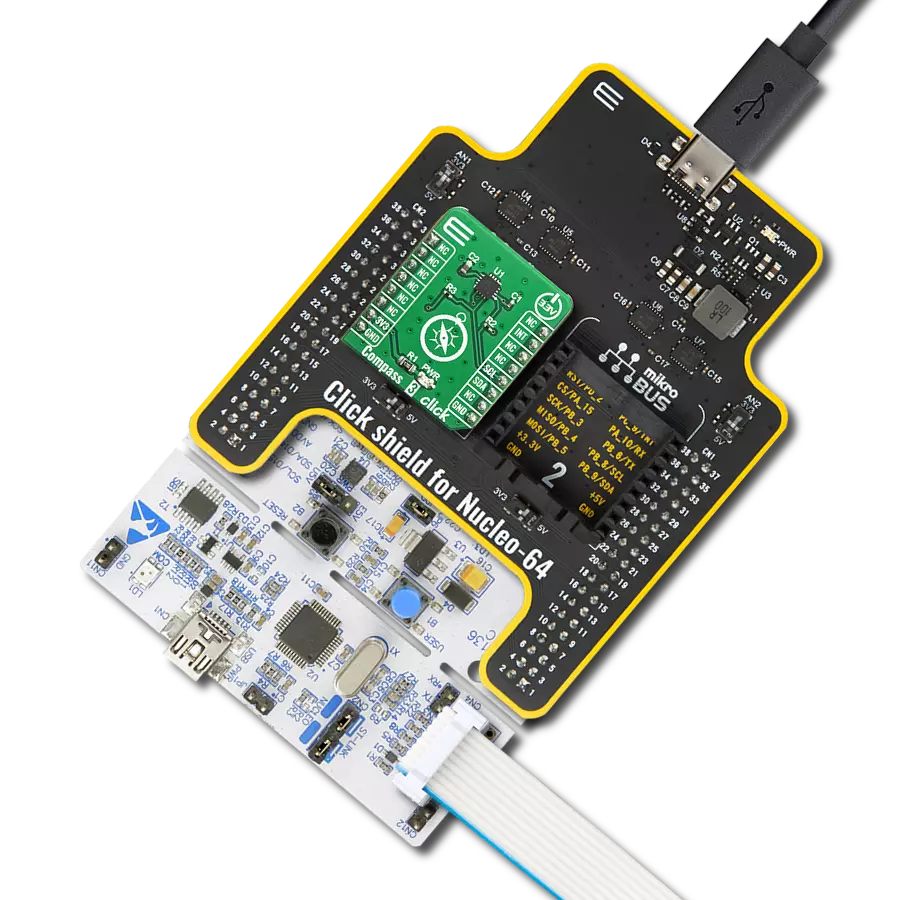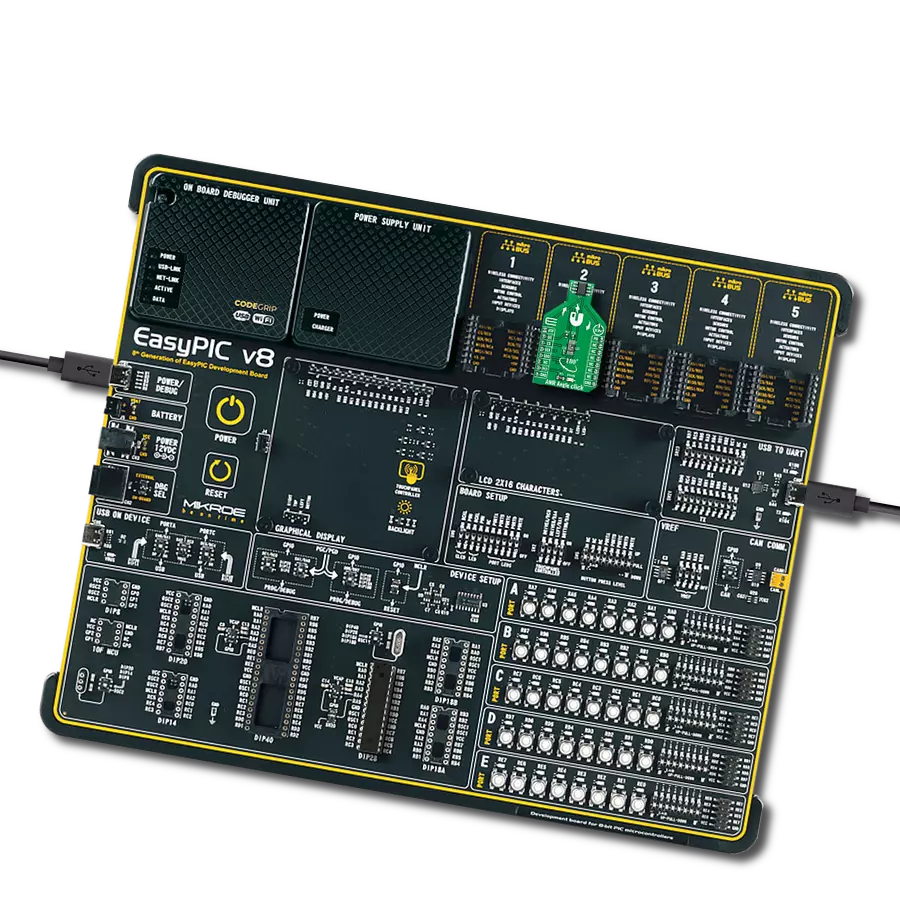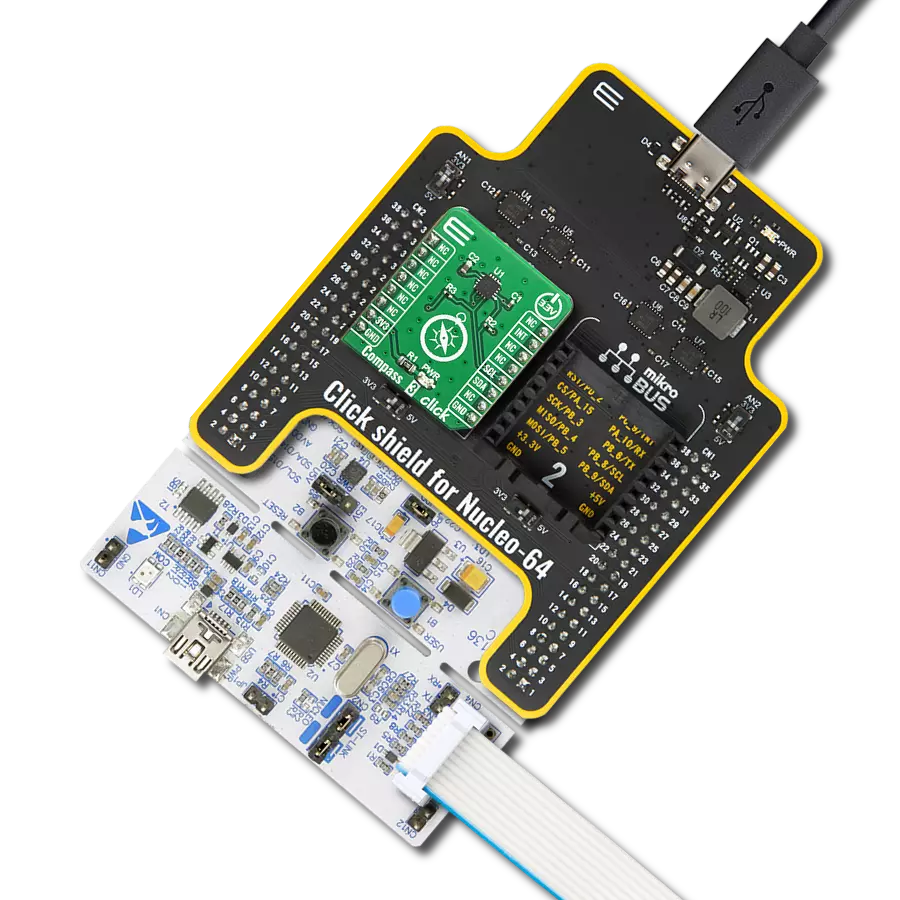Upgrade your solution capabilities by integrating magnetic position sensing, opening up possibilities for innovative applications like smart locks, thermostats, and more, with reliable position feedback
A
A
Hardware Overview
How does it work?
Magneto 8 Click is based on the AS5601, 12-bit programmable contactless encoder IC from AMS-AG. The AS5601 is a Hall-based rotary magnetic position encoder that converts the magnetic field component vertical to the surface of the chip into a voltage, which is used to produce incremental A/B outputs and absolute position indication. The analog signals from the Hall sensor are first amplified and filtered (before being converted by the ADC into binary data). Then, they are processed by the CORDIC block to compute the angle and magnitude of the magnetic field vector. The internal logic uses the angle values provided by the CORDIC algorithm to generate the incremental quadrature signals A and B. Additionally, the AS5601 implements a pushbutton detection function that indicates sudden
airgap changes between the AS5601 and magnet and drives the PUSH output pin high when the AS5601 detects a fast increase of the magnetic field and vice versa. The AS5601 communicates with MCU using the standard I2C 2-Wire interface with a maximum SCL frequency of 1 MHz. The I2C communication interface supports several different modes. In addition to the modes such as Standard, Fast, and Fast-Plus mode, there are three additional modes: Random/Sequential read, Byte/Page write, and Automatic increment relating to the ANGLE register. The AS5601 can be powered from a 5V supply using the on-chip LDO regulator, or it can be powered directly from a 3.3V supply. The selection can be done by positioning SMD jumpers labeled as VCC SEL to an appropriate position. In this case, there are
two voltage selection jumpers because the power pins of the AS5601 require a different configuration in the case of 3.3V and 5V power supply. In 5V operation, the second power pin must be connected to the ground via a decoupling capacitor C2. Otherwise, in 3.3V operation, the two pins must be tied together. Note that all the jumpers must be placed on the same side, or the Click board™ may become unresponsive. This Click board™ can operate with either 3.3V or 5V logic voltage levels selected via the VCC SEL jumper. This way, both 3.3V and 5V capable MCUs can use the communication lines properly. Also, this Click board™ comes equipped with a library containing easy-to-use functions and an example code that can be used as a reference for further development.
Features overview
Development board
PIC32MZ Clicker is a compact starter development board that brings the flexibility of add-on Click boards™ to your favorite microcontroller, making it a perfect starter kit for implementing your ideas. It comes with an onboard 32-bit PIC32MZ microcontroller with FPU from Microchip, a USB connector, LED indicators, buttons, a mikroProg connector, and a header for interfacing with external electronics. Thanks to its compact design with clear and easy-recognizable silkscreen markings, it provides a fluid and immersive working experience, allowing access anywhere and under
any circumstances. Each part of the PIC32MZ Clicker development kit contains the components necessary for the most efficient operation of the same board. In addition to the possibility of choosing the PIC32MZ Clicker programming method, using USB HID mikroBootloader, or through an external mikroProg connector for PIC, dsPIC, or PIC32 programmer, the Clicker board also includes a clean and regulated power supply module for the development kit. The USB Micro-B connection can provide up to 500mA of current, which is more than enough to operate all onboard
and additional modules. All communication methods that mikroBUS™ itself supports are on this board, including the well-established mikroBUS™ socket, reset button, and several buttons and LED indicators. PIC32MZ Clicker is an integral part of the Mikroe ecosystem, allowing you to create a new application in minutes. Natively supported by Mikroe software tools, it covers many aspects of prototyping thanks to a considerable number of different Click boards™ (over a thousand boards), the number of which is growing every day.
Microcontroller Overview
MCU Card / MCU
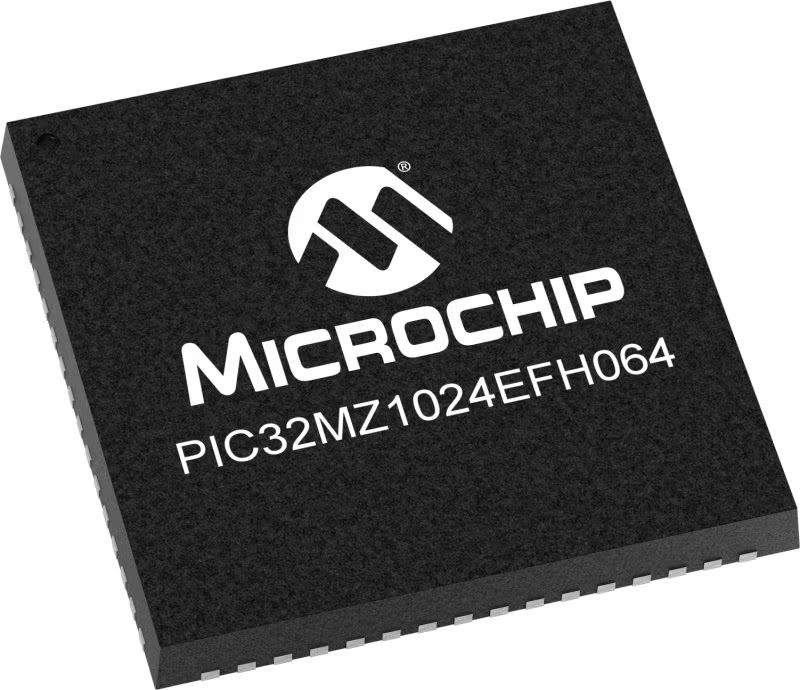
Architecture
PIC32
MCU Memory (KB)
1024
Silicon Vendor
Microchip
Pin count
64
RAM (Bytes)
524288
Used MCU Pins
mikroBUS™ mapper
Take a closer look
Click board™ Schematic

Step by step
Project assembly
Software Support
Library Description
This library contains API for Magneto 8 Click driver.
Key functions:
magneto8_get_magnitude- Gets magnitude datamagneto8_get_angle_data- Gets Angle datamagneto8_psh_pin_state- Gets PSH pin state
Open Source
Code example
The complete application code and a ready-to-use project are available through the NECTO Studio Package Manager for direct installation in the NECTO Studio. The application code can also be found on the MIKROE GitHub account.
/*!
* \file
* \brief Magneto8 Click example
*
* # Description
* This example demonstrates the use of Magneto 8 Click board.
*
* The demo application is composed of two sections :
*
* ## Application Init
* Initializes the driver and applies the Click default configuration.
*
* ## Application Task
* Reads angle and magnitude data and displays it on the USB UART every 500ms.
*
* \author MikroE Team
*
*/
// ------------------------------------------------------------------- INCLUDES
#include "board.h"
#include "log.h"
#include "magneto8.h"
// ------------------------------------------------------------------ VARIABLES
static magneto8_t magneto8;
static log_t logger;
// ------------------------------------------------------ APPLICATION FUNCTIONS
void application_init ( void )
{
log_cfg_t log_cfg;
magneto8_cfg_t cfg;
/**
* Logger initialization.
* Default baud rate: 115200
* Default log level: LOG_LEVEL_DEBUG
* @note If USB_UART_RX and USB_UART_TX
* are defined as HAL_PIN_NC, you will
* need to define them manually for log to work.
* See @b LOG_MAP_USB_UART macro definition for detailed explanation.
*/
LOG_MAP_USB_UART( log_cfg );
log_init( &logger, &log_cfg );
log_info( &logger, "---- Application Init ----" );
// Click initialization.
magneto8_cfg_setup( &cfg );
MAGNETO8_MAP_MIKROBUS( cfg, MIKROBUS_1 );
magneto8_init( &magneto8, &cfg );
magneto8_default_cfg( &magneto8 );
log_printf( &logger, "--- Configuration done ---- \r\n" );
Delay_ms ( 500 );
}
void application_task ( void )
{
float angle;
uint16_t mag;
mag = magneto8_get_magnitude( &magneto8 );
log_printf( &logger, "Magnitude: %d \r\n", mag );
angle = magneto8_get_angle_data( &magneto8 );
log_printf( &logger, "Angle : %.1f deg\r\n", angle );
log_printf( &logger, "---------------------- \r\n" );
Delay_ms ( 500 );
}
int main ( void )
{
/* Do not remove this line or clock might not be set correctly. */
#ifdef PREINIT_SUPPORTED
preinit();
#endif
application_init( );
for ( ; ; )
{
application_task( );
}
return 0;
}
// ------------------------------------------------------------------------ END


















